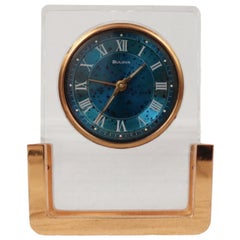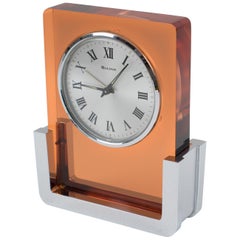Bulova Lucite Alarm Clock
Late 20th Century Japanese Modern Table Clocks and Desk Clocks
Brass
Recent Sales
Vintage 1970s Japanese Modern Table Clocks and Desk Clocks
Metal, Chrome
A Close Look at Modern Furniture
The late 19th and early 20th centuries saw sweeping social change and major scientific advances — both of which contributed to a new aesthetic: modernism. Rejecting the rigidity of Victorian artistic conventions, modernists sought a new means of expression. References to the natural world and ornate classical embellishments gave way to the sleek simplicity of the Machine Age. Architect Philip Johnson characterized the hallmarks of modernism as “machine-like simplicity, smoothness or surface [and] avoidance of ornament.”
Early practitioners of modernist design include the De Stijl (“The Style”) group, founded in the Netherlands in 1917, and the Bauhaus School, founded two years later in Germany.
Followers of both groups produced sleek, spare designs — many of which became icons of daily life in the 20th century. The modernists rejected both natural and historical references and relied primarily on industrial materials such as metal, glass, plywood, and, later, plastics. While Bauhaus principals Marcel Breuer and Ludwig Mies van der Rohe created furniture from mass-produced, chrome-plated steel, American visionaries like Charles and Ray Eames worked in materials as novel as molded plywood and fiberglass. Today, Breuer’s Wassily chair, Mies van der Rohe’s Barcelona chair — crafted with his romantic partner, designer Lilly Reich — and the Eames lounge chair are emblems of progressive design and vintage originals are prized cornerstones of collections.
It’s difficult to overstate the influence that modernism continues to wield over designers and architects — and equally difficult to overstate how revolutionary it was when it first appeared a century ago. But because modernist furniture designs are so simple, they can blend in seamlessly with just about any type of décor. Don’t overlook them.
Materials: Lucite Furniture
Antique, new and vintage Lucite furniture has been on design editors’ radars for several seasons now, but thanks to a renewed interest in Lucite coffee tables, chairs and other pieces from the late 1960s and ’70s, the trend has reached fever pitch.
“I think there’s a freshness and cleanness to it,” says Fawn Galli, an interior designer based in New York. Not only is Lucite, or transparent plastic, practical, since it can work in nearly any environment, it’s incredibly stylish.
Some of the most acclaimed furniture designers share the same love for Lucite as an effective and practical material for use in any interior.
“I think there’s something really nice about the simplicity of anything Lucite or acrylic — it feels lightweight,” says Tamara Eaton, whose eponymous firm deftly balances traditional and modern designs. Even in the most historical setting, “you can still introduce some Lucite or something kind of lightweight and not have it feel like a distinct interjection, but a playful one that’s more about the shape,” she says.
For the living room in a mid-century modern townhouse in Park Slope, Brooklyn, Eaton chose a pair of box-shaped Lucite tables with copper handles from Jamie Dietrich. “We didn’t want anything to be too heavy, and that area was a place where [the family] would sometimes move those tables so the kids could play,” she says. The tables doubled as snack trays since the kitchen is nearby. “They have this transportable feel to them that I think was really fun.”
Browse a range of antique, new and vintage Lucite side tables, table lamps and other furniture now on 1stDibs.
Finding the Right Table-clocks-desk-clocks for You
Whether you’re working on-site or giving your home office the makeover it deserves, a new, vintage or antique table clock or desk clock is a decorative touch that blends ornament and functionality. Who says that a unique desk clock isn’t a meaningful addition to your home office or library? And who says you don’t need a cool clock anymore?
While our means for telling time have evolved from pocket watches to wristwatches and finally to our digital phones, there is likely still a place for a table clock or desk clock in your life, even if it isn’t a modern desk clock.
Antique and vintage clocks appeal to our penchant for nostalgia, whisking us back in time to the 18th and 19th centuries, when clockmakers were busying themselves with designs for objects such as mantel clocks, then ornate pieces that were typically displayed on top of a fireplace. Tabletop clocks and desk clocks are variations on the carriage clock, a small, portable timepiece outfitted with a hinged carrying handle that garnered popularity as the growth of rail travel took shape.
Clocks make great collectibles. More than one mantel clock in your home library is going to elevate the space where your carefully curated stacks of books live, while a well-designed small decorative desk clock can be a fun way to express your personal style. Amid your inkwell, porcelain paperweights and other desk accessories, a desk or table clock designed during the Art Deco or Louis XVI eras, for example, is going to stand out in your workspace as a striking accent.
Since new, vintage and antique tabletop and desk clocks are not as common in today’s interiors, these objects will make a statement in yours. Find a spectacular clock on 1stDibs now.
Read More
10 On-Point Vessels for Flaunting Your Houseplants and Bouquets
Whether you're a genius gardener or have your florist on speed dial, every stem in your home deserves the best.
Jeff Andrews Captures Old Hollywood Glamour in His Cinematic Spaces
Having created extravagant homes for reality TV’s biggest stars, the designer is stepping into the spotlight with his first book.

